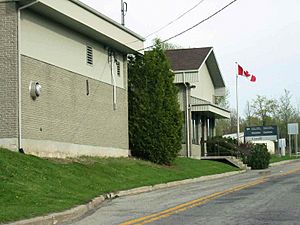Chateaugay–Herdman Border Crossing facts for kids
Quick facts for kids Chateaugay-Herdman Border Crossing |
|
|---|---|

Herdman, Quebec Border Inspection Station
|
|
| Location | |
| Country | United States; Canada |
| Location |
|
| Coordinates | 44°59′37″N 74°05′09″W / 44.993667°N 74.085781°W |
| Details | |
| Opened | 1933 |
| US Phone | (518) 497-6633 |
| Canadian Phone | (450) 264-5600 |
| Hours | Open 24 Hours |
|
U.S Inspection Station–Chateaugay, New York
|
|
| Location | NY 374, Chateaugay, New York |
| Built | 1932-1933 |
| Architect | Simon, Louis A.; Wetmore, James A. |
| Architectural style | Colonial Revival |
| MPS | U.S. Border Inspection Stations MPS |
| NRHP reference No. | 14000861 |
| Added to NRHP | September 10, 2014 |
The Chateaugay–Herdman Border Crossing is a special place where the United States and Canada meet. It connects the town of Hinchinbrooke, Quebec in Canada with Chateaugay, New York in the U.S. You can reach it using New York State Route 374 on the American side and Chemin Herdman on the Canadian side. This border crossing is always open, 24 hours a day, every day of the year.
Border checks started here in 1933. This was to help control things moving between the two countries. The main U.S. border station building and a home for border inspectors, built back then, are still used today. In 2014, these buildings were added to the National Register of Historic Places. This means they are important historical sites.
Contents
The U.S. Border Station at Chateaugay, New York
The U.S. border station in Chateaugay, New York, is a historic building. It faces east on a large piece of land next to New York State Highway 374. The area around it is mostly open fields and scattered farmhouses. The Canadian border station is also visible just a short distance away.
Building Design and Features
The main building has three parts. There's a central section made of white-painted brick with two smaller wooden wings on each side. The central part has a steep roof and several windows. The wings used to be a garage for government cars and a shed for inspecting vehicles. Some parts of these wings have been changed over time.
A canopy, or covered area, extends from the main building. This canopy covers two lanes where cars are inspected. It helps protect people from the weather. The building is designed in a style called Colonial Revival. This style was popular for public buildings in the 1930s.
Inside the building, the main area is open. There are counters where people can talk to border officers. The floors have red tiles, and the walls are plastered. There are also rooms in the basement and on the second floor. The second floor even has old detention rooms with barred windows.
Inspector's Residence
Near the main border station, there's a house that was built for border inspectors. It's a single-story building with a classic look, similar to a New England house. This house was designed to match the style of the main station but be a bit simpler. It's currently empty, but it's part of the historical complex.
Why This Station is Important
The Chateaugay Border Inspection Station is one of seven similar stations built between 1931 and 1934 along the New York-Canada border. These stations were very important for several reasons:
- Controlling Goods: In the early 1900s, there was a time when certain goods were not allowed to be sold or transported. These stations helped control what crossed the border. Even after those rules changed, the stations continued to be important for managing trade and travel.
- Creating Jobs: The stations were built during a difficult economic time. Building them provided jobs for many people who were unemployed. Local workers helped construct the station, and local residents became customs inspectors.
- Architectural Style: The station shows a specific type of architecture from that time. It was designed by Louis A. Simon, a well-known architect for the U.S. government. He wanted government buildings to look strong and classic. The Chateaugay station is a good example of this style, adapted to fit the local area.
The Chateaugay station is still in use today. It has kept much of its original look and feel. It's also one of only two stations that still have two original inspector's residences on site.
Canada Border Facilities at Herdman, Quebec
On the Canadian side, the main border station at Herdman is a large concrete building built in 1984. Before that, in the 1930s and 1940s, Canada used a different building for inspections. That old border station is still standing today, but it has been turned into a private home.
Images for kids





